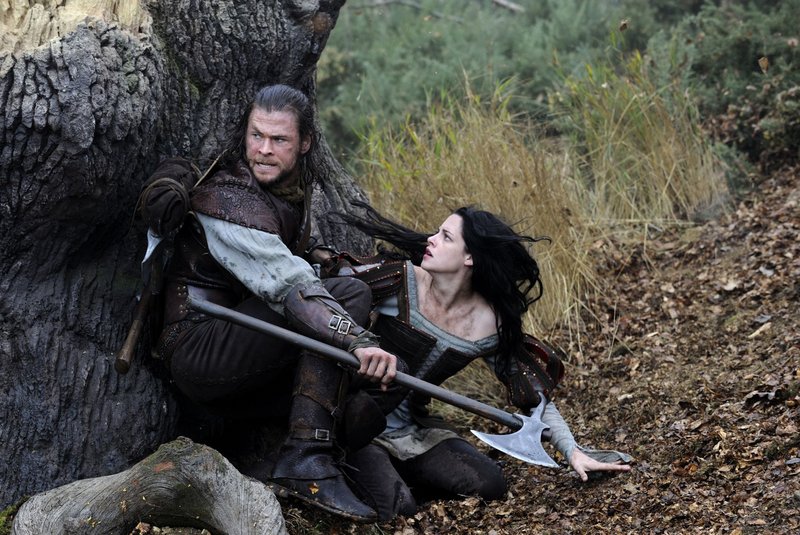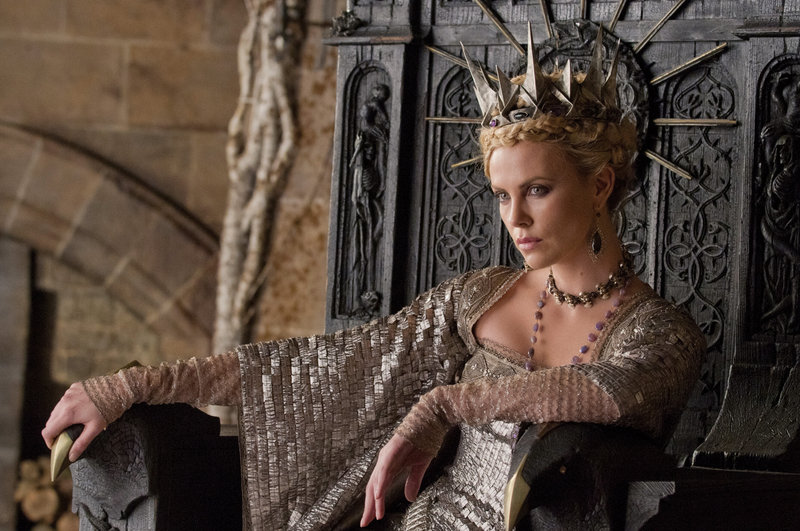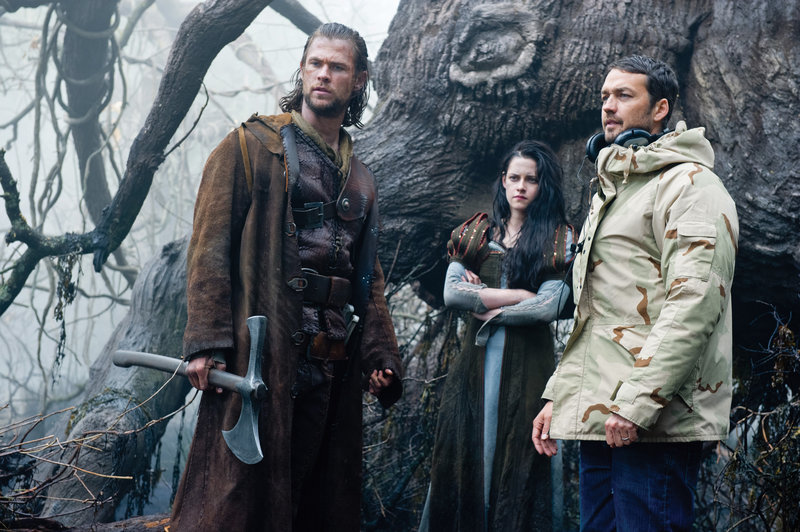Nearly a hundred soldiers on horseback sprinted across a beach in Wales last fall, dodging arrows and catapulted fireballs. Despite many casualties, the charging “Snow White and the Huntsman” army was determined to storm the castle of the evil Queen Ravenna, who not only can suck the beauty out of young women but also transmogrify into a murder of crows.
Assessing the battle from an all-terrain vehicle was Rupert Sanders, a commercial director making his first feature film. No one could accuse him of going timidly into new territory, for this was not just any entry-level first feature but a $175 million ambitious retelling of the Snow White fairy tale.
Expunged of its nursery school wonder and filled with young adult heartthrobs such as Kristen Stewart of “Twilight” and Chris Hemsworth of “Thor,” the film is dressed up with so many elaborate action scenes, fantasy frights and visual effects that it’s more superhero story than classic children’s fable, all done with a girl-power spin.
“You look around the corner, and you see that the circus has come to town,” Hemsworth said of all the chaos unfolding on the beach. “It’s an epic on a grand scale.”
Sanders’ challenge was to inject the classic “Snow White” story, which dates to the early 19th century, with contemporary relevance without losing the narrative’s familiar center. He also had to work closely with actors — something he did only fleetingly in his television commercial career — and give audiences a movie that didn’t look like a dusty costume drama or a kiddie flick.
“It feels like it could be a girly film,” said Charlize Theron, who plays Ravenna. “But more than anything, it’s an action-adventure piece set in an epic landscape.”
And while a typical summer blockbuster can take three years from inception to release, Sanders had about half that time to bring “Snow White” across the finish line for Universal Pictures, which was determined to have the movie come out June 1.
AN UNCONVENTIONAL CHOICE
Universal’s hiring of Sanders was unconventional but not totally out of the blue. The lanky 41-year-old Brit, who made award-winning commercials for Sears, Toyota and the video game Halo 3: ODST, had been considered for a number of prominent film jobs, including “The Hunger Games.”
Other directors like David Fincher and Michael Bay have made the leap, but success is hardly guaranteed.
“For every Ridley Scott, there’s 20 guys who don’t make it,” said “Snow White” producer Joe Roth, referring to the commercial director who went on to make films including “Gladiator,” “Black Hawk Down” and “American Gangster.” Roth said he was convinced Sanders was up to the job when he watched him direct a World War II-themed commercial for DirecTV.
“There were tons of people, hundreds of extras, explosions,” Roth said. “And he was very calm and collected in the middle of it. He was not going to get stage fright.”
But Sanders wasn’t sure he was ready for the spotlight and initially doubted he was the right person to direct “Snow White.” He signed on after realizing that he could straddle two worlds in the film — the real and the fantastic — and present a relatable, modern message. “Fairy tales are a parable,” he said. “They teach us something about how to behave, about the human condition,” Sanders said while editing in Los Angeles. “One of the characters in ‘Snow White’ suffers profound loss and kills, while another suffers profound loss and lives.”
As adapted by screenwriters John Lee Hancock (“The Blind Side”), Hossein Amini (“Drive”) and newcomer Evan Daugherty (who wrote the first draft in film school), the “Snow White” story follows the essential contours of the legend. While there’s a poisoned apple and a prince’s magical kiss, the movie makes narrative and thematic departures. The film’s tone is much more Brothers Grimm than Walt Disney, and its architecture calls to mind Peter Jackson’s Middle-earth and James Cameron’s Pandora.
Snow White (Stewart) has been imprisoned by the murderous Queen (Theron), whose thirst for eternal life and beauty has made her far more vampiric than regal. When Snow White escapes, the Queen recruits the drunken Huntsman (Hemsworth) to retrieve her stepdaughter.
Snow White runs into the forest and finds the woodlands both enchanting and foreboding. There are merry dwarfs (played in part by full-sized actors Bob Hoskins, Ray Winstone and Nick Frost) and a frightful, computer-generated troll. But it is Sanders’ use of visual effects, the work of 18 companies, that distinguishes “Snow White” from this spring’s “Mirror Mirror,” a much tamer and less expensive version of the same fable from Relativity Media that fizzled.
In “Snow White and the Huntsman,” the Queen ages years in seconds, plants wither and bloom instantly, the magic mirror melts into a golden anthropomorphic blob, the Queen alters her appearance (transforming into birds and another person) and obsidian-like shards of a ceiling form indomitable warriors.
INTENSE COMPETITION FOR MOVIE-GOERS
Such cinematic sleight-of-hand has become a requisite component of summer movies as studios pitch their productions to an audience that demands eye-popping action. If the PG-13 “Snow White” is to justify its massive cost, it must fend off the male-oriented “Men in Black 3,” which opened last week, and “Prometheus,” which opens next week. And it must attract moviegoers male and female, young and old — something not a lot of movies with a princess have done.
“It was a massive gamble,” Sanders said of taking on something so risky as his first film. “It’s movie jail or bust.”
For all of the film’s action and computer tricks, Sanders and his cast are hopeful that audiences are moved by the film’s heart and its take on female empowerment. “I set out to make an emotional blockbuster,” Sanders said. “So many blockbusters are fun to look at, but you leave feeling that your soul hasn’t been nourished.”
To create a story with sentiment, Sanders had to collaborate with his performers — something he didn’t gain much experience doing while crafting sales spots for cars and video games. “It’s a trap for commercial directors,” said “Snow White” producer Sam Mercer. “They’re used to working with images, not actors who have lots of dialogue.”
The “Snow White” cast said Sanders was unexpectedly open to their ideas — “We were obsessively changing things every day,” Stewart said — and was as interested in story as cinematography. The shoot lasted 80 days, and in addition to Wales, filming took place in England’s Bourne Woods, Burnham Beeches and London’s Pinewood Studios.
“If he only cared about visuals, I would not have wanted to be a part of that,” Theron said about why she decided to work with the first-timer. “He really wanted to explore the emotional core of the story and ground it in reality. He wanted these characters to be real.”
In an era when movie heroines essentially become as tough as men to triumph — think about any Angelina Jolie action movie — Sanders cautioned Stewart that “Snow White” was not “Kick-Ass” in period costumes.
“She’s not some lame imitation of a guy, some … loudmouth,” Stewart said of her character. “Every time I got excited about a bit of fight choreography, Rupert would said, ‘Nope, you can’t do that. You’re really tiny.’ The idea is that it’s easier to get behind someone who actually feels like a girl.”
Said Sanders: “Most intelligent men realize that women are running the show anyway. But there’s still an illusion in movies that it’s the other way around.”
Send questions/comments to the editors.





Success. Please wait for the page to reload. If the page does not reload within 5 seconds, please refresh the page.
Enter your email and password to access comments.
Hi, to comment on stories you must . This profile is in addition to your subscription and website login.
Already have a commenting profile? .
Invalid username/password.
Please check your email to confirm and complete your registration.
Only subscribers are eligible to post comments. Please subscribe or login first for digital access. Here’s why.
Use the form below to reset your password. When you've submitted your account email, we will send an email with a reset code.